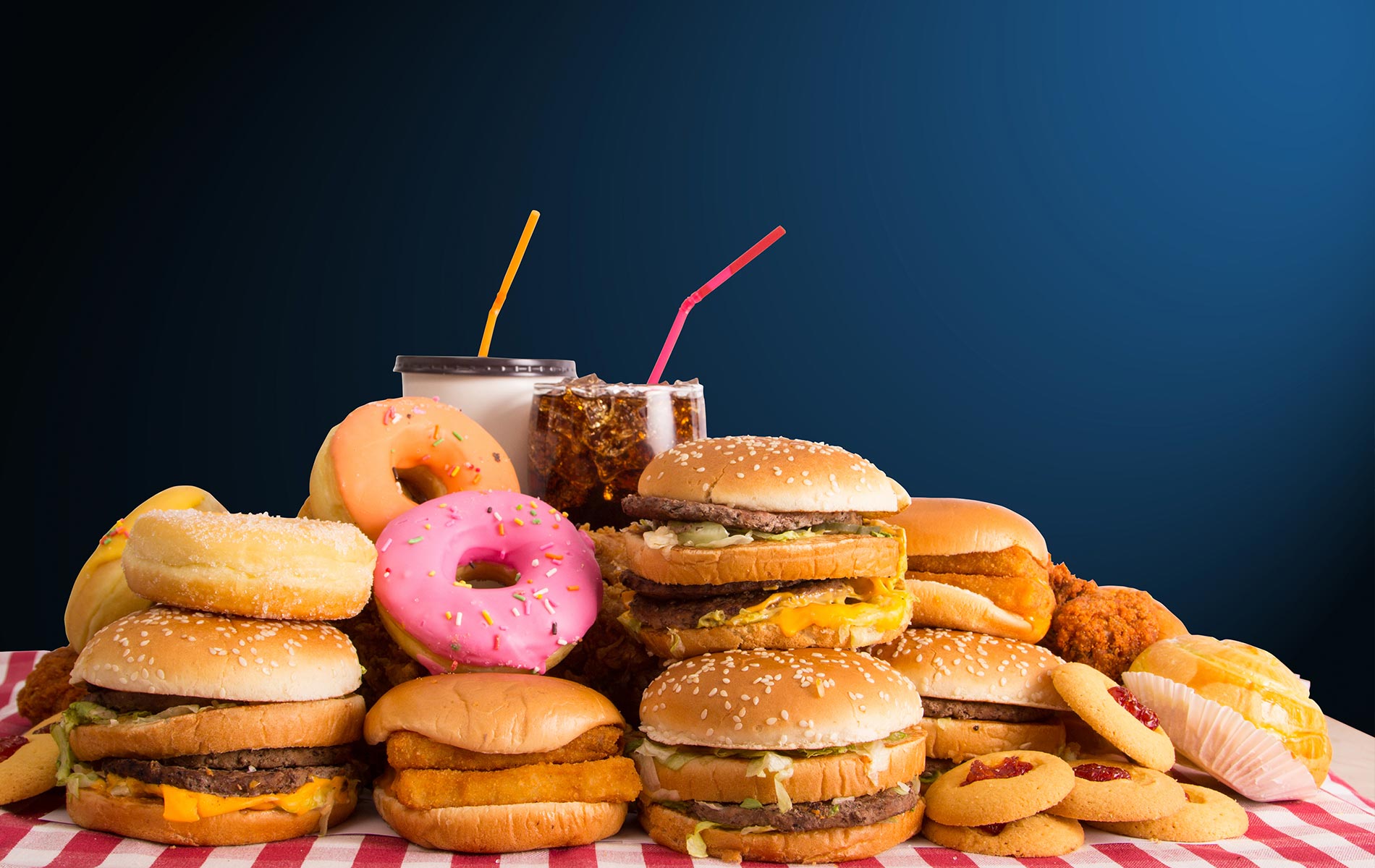
vie-magazine-obesity-hero
Obesity
The Girth of a nation
America enjoys the dubious distinction of being the heaviest nation on the planet. Lately, we have been increasing our lead (“lard”) . How and why is America so fat?
It is important to start with the understanding that humans have evolved to store any excess calories as fat. Our distant ancestors often faced food shortages due to weather (up to famine level) and evolved to store any excess calories in the good times as fat to insure against starvation when times got tough (i.e., food was scarce). Of course, today, famine is a remote possibility (at least in most of America), and, indeed, we have a surplus of calories readily available at all times—perhaps too readily. The statistics may put this abundance in perspective. The average woman needs to consume about 1,500 to 1,700 calories per day to maintain her weight. The average man needs to consume about 2,000 to 2,200 calories to maintain his. The food providers of America, who
Collectively supply “nutritional” products to the country, produce 4,000 calories per capita per day—approximately twice what we need to maintain our weight! Now, admittedly, there is some waste— restaurants throw away most of the food not consumed that day, and individuals throw out most of the leftovers from meals. But be assured the waste factor is nowhere near 50 percent! (Meaning that it is actually much less.) So, as a nation, we are eating more (much more) than we need to maintain our weight—hence weight gain.
WHY?
The following list is lengthy and not exhaustive, but it would behoove readers to glance over it in order to understand the various causes of obesity. Then they will be able to react appropriately to those factors that are under their control. And most have to do with our modern lifestyle.
Metabolism:
A prior article on exercise (Spring 2010) highlighted the sedentary nature of modern life. Calories are energy. Movement (increasing metabolism through exercise) requires more energy and burns calories. So lack of exercise and all our modern conveniences (cars, elevators, power equipment, remote controls, etc.) allow us to use fewer calories each day. We are consuming more calories than we need and expending fewer calories than we used to.
Unit bias and plate size:
Remember your mother’s admonishment? “Think of all the starving children in the world—clean your plate!” Mothers’ urgings became a mantra. We all try to finish what’s on our plates. But know this: plate size used to be ten inches—now it is twelve.
Super size me:
Everyone likes a bargain. Since incremental quantities (of calories or food) cost producers very little, they can give us a “bargain” by offering a lot more food for only a little more money. Good deal, right? Not for our waistlines (or our health). This way, the producers sell more (thus making more money) by enticing us to overeat through “bargain pricing.”
Addictive combinations:
Our ancestors, though they enjoyed salt, fat, and sugar, actually got very little of those ingredients. Today, many food-like concoctions on the shelf (I hesitate to call them food) are simply layers of salt on fat on sugar on fat on salt, etc. While tasty, these products have little or no nutritional value but are loaded with calories.
The Weight Gain/Loss Equation
A pound (of human) is the equivalent of 3,500 calories. Recall, men need approximately 2,000 calories and women around 1,500 calories daily to sustain the same weight. So gaining (or losing) weight is actually quite hard. We must create a surplus of 3,500 calories to gain one pound (or conversely, a deficit of 3,500 calories to lose one pound). Clearly, that is a lot of food over (or under) daily maintenance eating. But of course, people do not gain/lose a pound or two a day. Rather, increments of 100 to 500 calories per day add up over time. For example, just 200 extra calories per day translates into an extra pound in 17 days. That, in turn, equates to over 20 pounds per year! A few years of that kind of eating, and, bingo, we are obese. The reverse math is clearly what makes it so hard to lose weight. Depriving ourselves of a few hundred calories per day is much harder than indulging. And, in our society, the temptations to indulge are everywhere all the time.
Sugar
Well, all of these factors (and more) have contributed to the nation’s excess weight, but I believe the biggest contributor to our respective girth and ill health is the massive onslaught of sugar in our food supply. Trend data may illustrate why there is reason for concern. Our grandparents (in the 1940s) consumed about 10 pounds of sugar per year, mostly sucrose (table sugar) that was added to coffee, cereal, and some meals during the cooking process. Current data indicates that we consume 150 pounds per capita per year! Unfortunately, much of this sugar is hidden or disguised under other terms. But the fact remains that an enormous amount of sugar (and sugar substitutes) is in almost all packaged products. Additionally, all processed grains (white pasta, breads, muffins, etc.) are basically refined to the point of being predigested sugar by the time they hit the stomach.
So What?
Sugars are nutrition-less calories. The body reacts to a sugar overload by secreting large quantities of insulin, which, since the body cannot use all this excess energy for its current needs, packs the excess into fat cells. Continuing to stress the pancreas this way can eventually lead to type 2 diabetes in the long run, but, in the short term, it just
makes us fat. Most of the extra couple hundred calories per day mentioned earlier can be traced (in my opinion) to the hidden sugar in so much of our food supply. Incidentally, the overreaction to a sugar onslaught by the pancreas causes the stomach to empty quickly and results in feeling ravenous soon after—a double whammy for weight management.
The “F“ Bomb – Fructose
The true stealth bomber of sweeteners is not even called sugar. Although it has a variety of names (none of them include the word “sugar”), it is most commonly labeled as high fructose corn syrup (HFCS). Fructose is a fancy name for fruit sugar (any word ending in “-ose” is a sugar). Fruit sugar in moderation is good for us—if, of course, we are ingesting it by eating a whole fruit or vegetable (apple, pear, carrot, etc.). But HFCS is a different matter indeed. Back in the 1960s, HFCS did not exist. But when the government started subsidizing corn farming, and food manufacturers discovered that by refining the starch content into a syrup, they achieved a number of (for them) very desirable outcomes:
The GIRTH of a nation
Today, many food-like concoctions on the shelf (I hesitate to call them food) are simply layers of salt on fat on sugar on fat on salt, etc.104 SUMM ER 2010 VIEzine.com So what? HFCS is just another sweetener, right? Well, all sugar is bad for us—99 percent of refined sugar is pure calories—no vitamins, minerals, fiber, or proteins, just simple carbohydrates. HFCS, however, takes these drawbacks to a new level.
Here is a short list of how HFCS affects the body:
ECONOMICS:
HFCS turned out to be the cheapest way to sweeten food.
TASTE:
HFCS is very sweet and improves the taste of food dramatically.
MOUTH FEEL:
The addition of HFCS gives improved mouth feel—that melty, chewy delight on the tongue.
SHELF LIFE:
Shelf life is greatly improved with HFCS.
ADDICTION:
HFCS is at least mildly addictive—people come to prefer foods sweetened with HFCS over the same foods sweetened any other way.
APPETITE ENHANCEMENT:
HFCS inhibits the hormones that signal the brain that we are full.
Well, that’s quite a list of incentives for food manufacturers to use HFCS—and use it they do! HFCS is in almost every packaged food.
From 1970 to 1990, our intake of HFCS rose 1000 percent, paralleling America’s surge in obesity. Of the 150 pounds per capita per year mentioned earlier, about half is now HFCS.
It readily converts to fat in the liver. A fatty liver is less effective at handling wastes and toxins. It raises triglycerides (blood fat)—not good for circulation—think coronary events. It decreases insulin sensitivity—think diabetes in the long term. It is implicated in elevated blood cholesterol and even clotting—think heart disease. Perhaps worst of all, HFCS causes the white blood cells in our immune system to become “sleepy,” thus reducing their effectiveness in dealing with foreign substances. HFCS is everywhere: ketchup, soup, salad dressings, baked goods, cereals, etc.—places where we least expect it. To cut back, please start reading ingredient labels on the package. Manufacturers are required to list their ingredients by weight (from most to least). So if HFCS (or any sugar—none of it is good for us) is in the top three ingredients, that particular product is loaded with harmful, empty calories. In general, we would all do better to eat less food with more of it coming directly from nature, become more active, and, particularly, break our sugar addiction. Reading ingredient labels can at least inform our decisions about whether we put a product in our bodies. Most will be shocked to see how much of our food is packed with those nutritionless calories called sugar, especially HFCS. So to get back to being lean, America must “lick” its sugar addiction.
— V —
The Health Nut
Clark Peters has spent much of his time since his retirement in 1997 researching health and longevity. His purpose in writing these columns is to share his findings with readers in plain English and assist them in making accurate and informed lifestyle choices. The columns are based on the premise that we all want to live a long, vigorous life and are striving to make healthy choices. While Mr. Peters believes these recommendations will result in better health and longevity for almost everyone, the reader is advised to consult with his or her physician before making any major lifestyle changes.
Share This Story!
KEEP UP WITH THE LATEST STORIES FROM VIE


































































































































